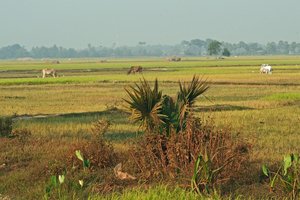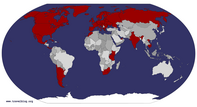Advertisement
Published: January 7th 2017

 Irrigated fields
Irrigated fields
Every stage of rice cultivation is productive.We drove into the countryside this morning for a village visit on
Tonle Sap Lake. Noy asked the driver, Phol, to take back roads so I could see country life. Along the way there were villages and towns with settlement in-between. Cambodia has fifteen million people, and later I learned that almost half a million live in floating villages on this great lake. Siem Reap has 130,000 residents.
Traditional houses are built on stilts; the one large room is a sleeping area for families of about 10. The stilts are at least one storey high, some almost two storeys. The days and evenings are spent in this shady and cooler area. Casual furniture, goods and motorcycles share the space with the family members. Some newer traditional houses have about half of the lower level built into the house, leaving the other half to function as a shaded patio. Other newer houses are more conventional cement houses on one level, usually with an awning that sweeps down from the roof. Roofing materials are ceramic tile, tin, steel, and for the poorest, grass. Noy often refers, bitterly, to the time of the civil war and particularly the poverty during the Pol Pot years when

 New house, traditional style
New house, traditional style
Shaded comfort all day, sleep upstairspeople were pushed out of the cities.
Rice is the second largest sector of the economy, after tourism. We drove past dry paddies, then paddies with cattle munching on the straw, and finally green irrigated paddies. At the end of the day we also saw women transplanting rice seedlings from one paddy field into another paddy where they will grow and mature for harvest.
From a rural laterite road we turned onto a rougher laterite road, which is rebuilt every year after the rains, funded in part by a toll. We were now in the Lake, so to speak, and soon we were on a dusty sand “road”, more of a place to drive on at extremely slow speed. This gigantic lake rises several metres in depth, thus many kilometres in spread every rainy season in September-October and shrinks throughout the rest of the year. Where we were driving will be under at least two metres of water in the fall, with all the bushes disappearing from sight. During the wet season fish nest in the trees, instead of birds ! Fishermen are not allowed to catch fish then; in any case they prefer to work when the

 Lake bed of Tonle Sap Lake
Lake bed of Tonle Sap Lake
Road for part of the year, lake in the wet seasonwater is lower because the fish are easier to catch.
At last we came to a mooring place for lots of long boats. I clambered ungracefully on to a seat in front of Noy, and the boatman started up the engine at the back. The engine is quite small and turns a long shaft for a propeller with blades about fifteen inches long. It made a horrible racket! We were in a long arm of the lake, only about thirty feet across at this time of the year. The main part of the lake that never drains is about forty miles from our location; it is part of the
Mekong River system.
A few white cranes flew up from the edges, only moderately startled by our noisy passing. It was me who was startled - by the wake that “tossed” us when another long boat passed by. Grabbing the side of the boat was completely unnecessary as the boat bobbed with perfect balance. The channel widened gradually, and we came to the floating village, Mechrey.
At first I thought there were just a lot of house boats in a row, until they were on either side, and I

 Mechrey village
Mechrey village
Ingenious adaptation to watery environment.saw shops and cafes! Unlike house boats I had seen before, these were not meant to be used for sailing, that is, they were square houses built on bamboo rafts, tethered to poles pushed into the mud. However, these houses are moved, about every two weeks, as the water-level lowers and rises. The villagers stay at the same relative depth by upping the stake and poling to new locations. Noy remarked that they might move a hundred times during the year!
In front and under each house is a Catfish farm, made of bamboo or wood, woven into a rectangle about eight by ten feet, and of some depth. This is for family consumption and even for sale during the wet season when the fishermen are on hiatus. One house had a floating pig pen! Of course, everything for the household takes place on the floating platform. Children are taught how to swim at the age of two, and Noy explained they are often left unattended all day as the parents have to work. The village does have a school – a set of floating schoolrooms, loosely joined by a walk way. Otherwise, boats are the only way to
move about the village. Vendors ply up and down the village with staples and fresh fruits and vegetables. No one has much cash; a new fishing boat must be purchased every ten years and fishing nets must be replaced every five years, even with annual maintenance.
We did stop at a crocodile farm and tourist shop. Crocodiles are kept in watery cages. The trade is lucrative (for a fisherman), and all crocs are sent live to China and Korea where the skins are made into products. Alongside the tank with the babies was a tank with water snakes (black, about two feet long and an inch thick); these are raised for food. Gradually it dawned on me that I was expected to buy something, and indeed when I concentrated, a soft black and teal scarf beckoned. And I gave into temptation by buying a light decorative bag. After minimal bargaining, we agreed on $11 for the two. A bargain to me and a reasonable price to the young woman vendor. Noy thought $10 was the right price.
Thus, we retraced our ride up the arm of the lake, and I clambered out without too much trouble. Happy to

 Banteay Srei
Banteay Srei
Complex architecture and carved stonehave lots of photos.
One last temple was on our schedule, the oldest one known, from the mid-ninth century. We drove some distance past Angkor Wa; a king’s teacher built Banteay Srei for himself and placed it well away from the royal buildings to avoid the appearance of competition. Impressive today are the deeply carved adornments, which have consequently endured the ravages of weather over the centuries. The scale is much smaller than the two large Angkor Temples. Exquisite detail pays homage to Hindu gods and stories, framed by delicate stone leaves. The unusual red and pink sandstone has weathered into a rosy gold that looks like sunset glows even in the strong mid-day light.
Late lunch was gratefully welcomed at a nearby restaurant. Noy gave me relief from the set menu, almost always fish amok and grilled chicken. He ordered me fried spring rolls as a starter (they are very bland), and I ordered seafood noodle soup (not Cambodian, but delicious), and fresh pineapple and watermelon completed the meal. The restaurant was large and open to a pleasant mild breeze.
Our final visit for the day was the
Landmine Museum. Extraordinarily,
Aki Ra, the founder, was a
CNN Heroes award recipient, just as last year in South Africa where we visited the Kliptown Youth Project whose founder had been similarly honoured. This man was orphaned at the age of five, “recruited” into the
Khmer Rouge army at the age of ten, and was a particular success in setting landmines. He defected to the Cambodian army after several years, where he continued with his specialty. Eventually horrified by the damage his young self had caused, he dedicated his life to personally demining villages. He collected tens of thousands of defused ordinance in his home as a museum to the destructiveness of the civil war. About ten years ago, he was forced to stop his practices because they didn’t meet international standards for safety. After a pause, he set up an NGO, the
Cambodian Self Help Demining organization, supported by a number of agencies. Under international protocols, mines are now blown up in situ.
His story is told by the museum in informational displays. In the centre is a glass-enclosed gazebo full of his damning collection of mines and ordinance made by major nations, in particular Russia, US, Korea, and China. An audio guide was helpful in understanding the destruction and carnage caused by

 Landmine Museum
Landmine Museum
Horrifying collection dug up by Aki Raindiscriminate bombing with landmines. Aki Ra's organization concentrates on small farms and other pieces of ground considered low priority by the larger organizations; it does receive funding from some of these big NGOs. Even more important, Aki Ra adopted 27 maimed children during his years of demining; now he has set up a residential school, fortunately no longer just for mine victims but for abandoned and handicapped children. Posted essays by some of the children were even more moving than the sight of the piles of reclaimed ordinance. From the shop I bought a pretty scarf and made a donation.
Dinner tonight was at a beautifully designed restaurant catering to tourists in this tourist town. Unfortunately, the set menu was the fish amok (different style at least) and grilled chicken again. The starter cabbage salad was refreshing. Glass of cabernet sauvignon for a change.
">View a slide show of Banteay Srei.
























Isabel Gibson
non-member comment
A full day
A great write-up and wonderful photos, especially of the floating village. (The picture of the props on extended arms/poles was especially helpful for me, visually and mechanically challenged as I am.) As for the structures, nothing like seeing them to actually get it. But 500,000 people living on the lake - my word.